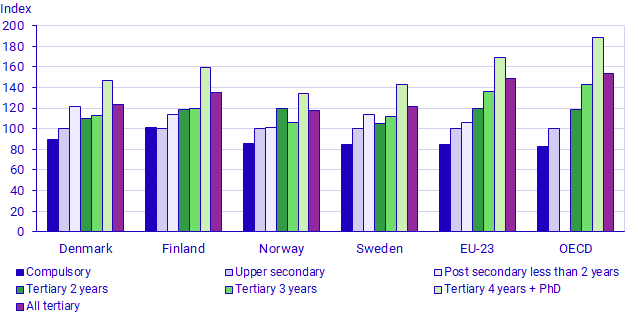Relative earnings from an international perspective
Higher education in Sweden leads to second lowest wage premium in OECD
Earnings are less affected by educational attainment in Sweden than in other countries. A Swedish tertiary education yields an average salary that is 22 percent higher than an upper secondary education. The corresponding average among OECD countries is 54 percent.
Our Nordic neighbouring countries also have lower wage premiums for longer post-secondary education than the OECD average. Norway is the only OECD country with lower wage premiums than Sweden. Finland stands out somewhat among the Nordic countries and is closer to the OECD average.

Largest gender salary gap among highly educated people
The statistics also show that there is a gender salary gap related to educational attainment and scope of employment. In Sweden, women earn on average 85 percent of men’s salaries. The higher the educational attainment, the larger the gender salary gap. Women with a high level of educational attainment working full-time only earn 78 percent of the earnings of their male peers. However, among the Nordic countries, Sweden has the smallest gender salary gap. Furthermore, taken together, the Nordic countries are not more gender equal than the OECD average.
Besides educational attainment and sex, other factors that appear to affect earnings include age, educational orientation, and the percentage of highly educated people in the population.
Publication
A more detailed presentation of the results is included in the report (in Swedish):
Löneskillnader i ett internationellt perspektiv, statistik från OECD om lön i relation till utbildningsnivå
A short article based on the report is also available (in Swedish): Sämre lön för högre utbildning i Sverige
Feel free to use the facts from this statistical news but remember to state Source: Statistics Sweden.
